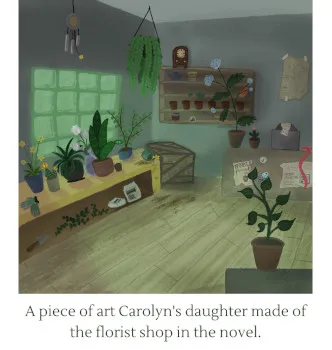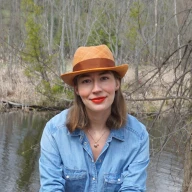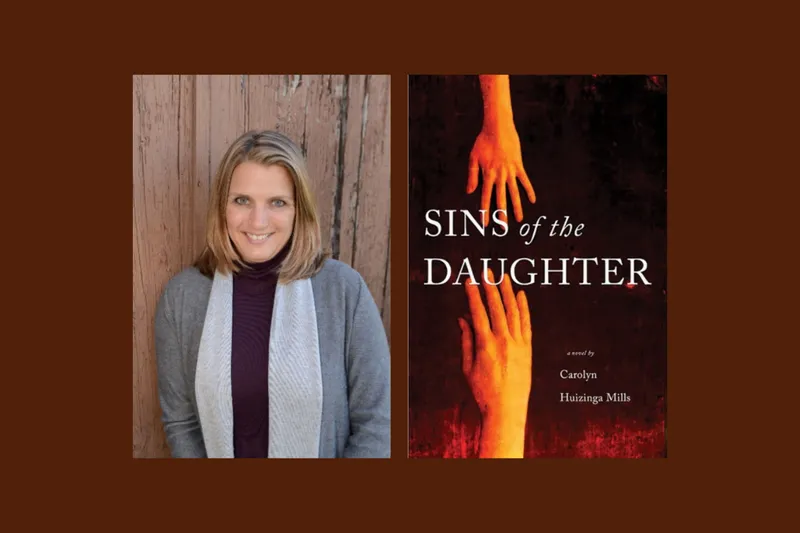Ever since reading L.M. Montgomery’s Emily of New Moon as a child, Carolyn Huizinga Mills has dreamed of being a writer. She began writing short stories and in 2017, her story “Finders” placed second in the Alice Munro Short Story Competition. Carolyn’s first picture book, The Little Boy Who Lived Down the Drain, was chosen as a 2018 Blue Spruce Honour Book, and her second picture book, Grandpa’s Stars, is scheduled to be released this fall. Her first novel, The Good Son, was published in 2021. Sins of the Daughter is her second novel.
A grade seven teacher, Carolyn loves to share her passion for reading and writing with her students. She grew up in Calgary, Alberta, and now lives in southwestern Ontario with her husband and two children. In addition to reading and writing, Carolyn enjoys playing soccer, camping, travelling, and eating dark chocolate.
Could you tell us briefly what Sins of the Daughter is about?
Carolyn Huizinga Mills: Sins of the Daughter is a story about generational trauma. It revolves around a mother’s disappearance and tracks the events leading up to that moment as well as those that follow. The story is told from the perspectives of three generations of women: Danah, her mother (Jane Lily), and her grandmother (Edith). Much of the story is set in southwestern Ontario, but parts of it also take place in Vancouver, as well as in one of my favourite cities, Edinburgh.
Does one of your characters hold a special place in your heart? If so, why?
CHM: Jane Lily (Danah’s missing mother), is a complicated and sometimes unlikable character, but I really loved writing her scenes. Her relationship with her mother was fraught, to say the least, and lends insight into what made her the kind of mother she was. I felt for all of my characters, but she stands out because of her particular and unremitting struggles.
While writing your book, what was the most surprising thing you discovered or learned?
CHM: That I could finish a book! I used to think I would never finish this manuscript (I spent years not finishing it), but then I did a webinar on “how to finish your book in thirty days”, which involved dedicating ninety minutes every day to writing (no re-writing, no editing, just forward momentum), and lo and behold, I finished the book. It was a long way from being truly finished, as in polished or perhaps even readable, but for the first time I had a complete draft with an actual ending. That single accomplishment motivated me to keep working on it, along with a fierce refusal to give up on this story that had pretty much taken up permanent residence in my brain and my heart.
In Sins of the Daughter, Danah finds a letter she is convinced is from the mother who abandoned her. What special meaning does letter writing hold for you?
CHM: There’s something uniquely personal about receiving (or sending) a physical letter. Although I haven’t written a proper letter in years, I used to exchange letters with a friend in Australia, on super thin airplane paper, and those letters are so much more memorable to me than our current email exchanges or WhatsApp conversations. For the novel, I needed the presence of the letter to be tangible, and I wanted everything about it (the quality of the stationary, the spidery script on the envelope) to leave an impression.
When it comes to plotting your novels, do you have the whole book outlined before you write? Do you use any specific strategies or techniques?
CHM: Ha! I wish! I love the structure and organization and idea of outlines, but I am a pantser (for better or worse) all the way. Then later, I go back and try to make sense of the mess I’ve created. Still, I love discovering parts of the story unfold in ways that surprise me, sometimes because until I wrote a particular sentence I didn’t know that specific thing was going to happen. For example, in one of my current works-in-progress, a character asks where her dad is and her mother’s answer reveals something about her father I hadn’t known up until that moment. I was just as caught off guard as my character.
What does your typical writing day look like?
CHM: I’m a teacher, so during the school year, I get up early to write before the busyness of the day takes over. I set my alarm for 4:45 so I can have my tea made and the news read before 5:00, then I write for about an hour and a half. I’ve learned I’m much more productive in the morning (when it’s quiet and there are no other distractions) than I am in the evening. Plus, there’s something very satisfying about starting the day knowing I already got some words in.
What books have most influenced you as a writer?
CHM: Right now I’m working my way through Story Genius by Lisa Cron and if anything will make me start outlining (or blueprinting as Lisa would say) it’s that book. As for fiction, almost everything I read influences me. A vivid description, and I want to analyze it. A deft switch to a flashback, I want to study how it was done. Some books that I have read over and over include: Cat’s Eye by Margaret Atwood, Crow Lake by Mary Lawson, and Clara Callan by Richard B. Wright. I return to those books for inspiration and with the barest hope that some of their genius will rub off on me.
Books can transport readers to another world, another place or time. In real life, what’s your favourite place to visit and why?
CHM: I recently returned from a visit to Quebec City and I was absolutely enthralled with both the Upper Town and Lower Town of Old Quebec. The city is so steeped in history it really was like being in another time. For the same reason, I love cities like Edinburgh. Give me cobblestone streets, stone structures, shuttered windows, narrow passageways, towering castles… I would go back to either of those places in a heartbeat.
If you could give just one piece of advice to aspiring writers, what would it be?
CHM: Believe in yourself. Chase your dreams. (Technically, I guess that’s two pieces of advice, but they go hand in hand.)

Here’s a sneak peak at Sins of the Daughter…
I used to wish my mother was dead.
I went through a phase where I spent hours constructing elaborate fantasies about how she died, each one more detailed and tragic than the last. It wasn’t that I actually wanted her to be dead; what I wanted was an explanation for her abandoning me, for sending me off to school one morning, then disappearing from my life like a wisp of smoke.
Mothers aren’t supposed to abandon their children. It goes against gender norms. I know a lot about norms, and the kinds of people who break them. I study deviance. Not because of what happened, though. Choosing to pursue a PhD in Sociology had nothing to do with my mother’s cold rejection; I chose this discipline because of my dad. I wanted to follow in his footsteps, big as they are. Still, what kind of mother walks away from her only child? Fathers, yes – they have more latitude in the parenting department. But mothers? They’re supposed to stay.
I remember her standing on the porch. Her long, curly hair fell in waves over her shoulders and she was wearing a loose t-shirt with a pair of white-washed jeans. It must have been one of her mornings off. She wore nicer clothes on the days she worked at Noble’s Florist. She was smiling. I remember that, too. It was her smile that tricked me. I thought it meant she was happy.
Visit Carolyn Huizinga Mills on social media!

About Vanessa Westermann
Vanessa is a Canadian crime writer. She is the author of Cover Art and other books. At the heart of all of her stories are strong female protagonists.

